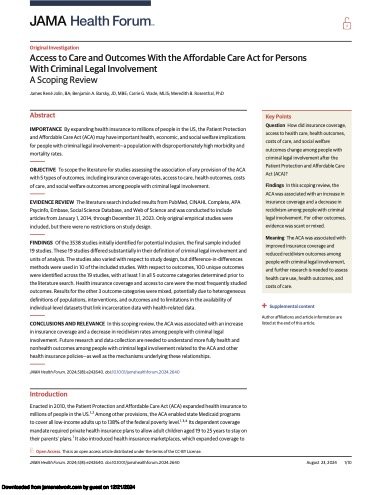By NACRO
The issues of prisoner healthcare are not new, but in publishing this report including the direct experiences of people who have been through the prison system, we hope to bring these concerns to the forefront of thinking, and engage in collaborative discussions about solutions.
In order to explore the issues with physical healthcare in prison, we carried out a survey of people who have been released from prison and have received support from Nacro with their resettlement journey. We asked people to complete the survey if they had been released from prison in the last five years, although it is important to acknowledge that their survey responses may relate to more historic experiences. 101 people completed the survey between May and October 2024.
This briefing examines:
the physical health of people in prison, and how this is generally worse than people in the community;
the impact of imprisonment on physical health, including the impact of overcrowding and unsanitary conditions, lack of purposeful activity and poor quality diets;
the problems and barriers to accessing healthcare services, including difficulties in accessing treatment and lengthy waiting lists, missed appointments, issues with medication, feeling ‘unseen’, and issues on transfer between prisons and on release.
Nacro Physical Healthcare Survey key findings:
Almost half (43%) said they did not get the treatment they needed from the medical professionals they saw
Three quarters of people (75%) said they were aware of people not able to get the medication they needed whilst in prison and 65% said that they saw people using other people’s medication. 64% said that they knew people who used illegal substances because they couldn’t get the medication they needed
60% said they had a longer period of pain and discomfort because they did not get the treatment they needed, and 12% said that because they did not get the treatment they needed they were then not able to work when they were released from prison
A third of people (34%) who reported they had appointments at a hospital outside prison during their sentence were not able to attend the appointment
One third of people (34%) were aware of people who had resorted to doing dentistry on themselves or others because they were unable to see a dentist
40% waited for a month or longer for a GP appointment, and a further 7% said they never got an appointment
More than one in three (38%) waited longer than three months for a dentist appointment, with a further 24% saying they never got an appointment
Over a third of people (35%) who needed to see an optician said they never got an appointment
Summary of our main recommendations
We set out recommendations at the end of this report which we believe will help people in the
justice system get the support they need with their health. These are grouped as follows:
Tackling the overuse of imprisonment: Policies that aim to reduce overcrowding and reduce our reliance on imprisonment by providing community alternatives must form part of the solution.
Limiting the impact on physical health: We set out recommendations that we believe will help to tackle the fundamentally unhealthy environment of prisons.
Overcoming the barriers to accessing healthcare services: We set out recommendations to address the issues that prevent people from getting the treatment and support they need.
The Better Futures Project Briefing 3
London: NACRO 30p.
By Pasangi S. Perera, Vanessa E. Miller,; Kate Vinita Fitch, et al
Since 2014, Medicaid expansion has been implemented in many states across the US, increasing health care access among vulnerable populations, including formerly incarcerated people who experience higher mortality rates than the general population. OBJECTIVE To examine population-level association of Medicaid expansion with postrelease mortality from all causes, unintentional drug overdoses, opioid overdoses, polydrug overdoses, suicides, and homicides among formerly incarcerated people in Rhode Island (RI), which expanded Medicaid, compared with North Carolina (NC), which did not expand Medicaid during the study period. DESIGN, SETTING, AND PARTICIPANTS A cohort study was conducted using incarceration release data from January 1, 2009, to December 31, 2018, linked to death records from January 1, 2009, to December 31, 2019, on individuals released from incarceration in RI and NC. Data analysis was performed from August 20, 2022, to February 15, 2024. Participants included those aged 18 years or older who were released from incarceration. Individuals who were temporarily held during ongoing judicial proceedings, died during incarceration, or not released from incarceration during the study period were excluded. EXPOSURE Full Medicaid expansion in RI effective January 1, 2014. MAIN OUTCOMES AND MEASURES Mortality from all causes, unintentional drug overdoses, unintentional opioid and polydrug overdoses, suicides, and homicides. RESULTS Between 2009 and 2018, 17 824 individuals were released from RI prisons (mean [SD] age, 38.39 [10.85] years; 31 512 [89.1%] male) and 160 861 were released from NC prisons (mean [SD] age, 38.28 [10.84] years; 209 021 [87.5%] male). Compared with NC, people who were formerly incarcerated in RI experienced a sustained decrease of 72 per 100 000 person-years (95% CI, −108 to −36 per 100 000 person-years) in all-cause mortality per quarter after Medicaid expansion. Similar decreases were observed in RI in drug overdose deaths (−172 per 100 000 person-years per 6 months; 95% CI, −226 to −117 per 100 000 person-years), including opioid and polydrug overdoses, and homicide deaths (−23 per 100 000 person-years per year; 95% CI, −50 to 4 per 100 000 person-years) after Medicaid expansion. Suicide mortality did not change after Medicaid expansion. After Medicaid expansion in RI, non-Hispanic White individuals experienced 3 times greater sustained decreases in all-cause mortality than all racially minoritized individuals combined, while non-Hispanic Black individuals did not experience any substantial benefits. There was no modification by sex. Individuals aged 30 years or older experienced greater all-cause mortality reduction after Medicaid expansion than those younger than 30 years.
JAMA Netw Open. 2024, 12 p.
By James René Jolin, Benjamin A. Barsky, Carrie G. Wade
By expanding health insurance to millions of people in the US, the Patient Protection and Affordable Care Act (ACA) may have important health, economic, and social welfare implications for people with criminal legal involvement—a population with disproportionately high morbidity and mortality rates. OBJECTIVE To scope the literature for studies assessing the association of any provision of the ACA with 5 types of outcomes, including insurance coverage rates, access to care, health outcomes, costs of care, and social welfare outcomes among people with criminal legal involvement. EVIDENCE REVIEW - The literature search included results from PubMed, CINAHL Complete, APA Psycinfo, Embase, Social Science Database, and Web of Science and was conducted to include articles from January 1, 2014, through December 31, 2023. Only original empirical studies were included, but there were no restrictions on study design. FINDINGS Of the 3538 studies initially identified for potential inclusion, the final sample included 19 studies. These 19 studies differed substantially in their definition of criminal legal involvement and units of analysis. The studies also varied with respect to study design, but difference-in-differences methods were used in 10 of the included studies. With respect to outcomes, 100 unique outcomes were identified across the 19 studies, with at least 1 in all 5 outcome categories determined prior to the literature search. Health insurance coverage and access to care were the most frequently studied outcomes. Results for the other 3 outcome categories were mixed, potentially due to heterogeneous definitions of populations, interventions, and outcomes and to limitations in the availability of individual-level datasets that link incarceration data with health-related data. CONCLUSIONS AND RELEVANCE- In this scoping review, the ACA was associated with an increase in insurance coverage and a decrease in recidivism rates among people with criminal legal involvement. Future research and data collection are needed to understand more fully health and nonhealth outcomes among people with criminal legal involvement related to the ACA and other health insurance policies—as well as the mechanisms underlying these relationships.
JAMA Health Forum, 2024, 10 p.





